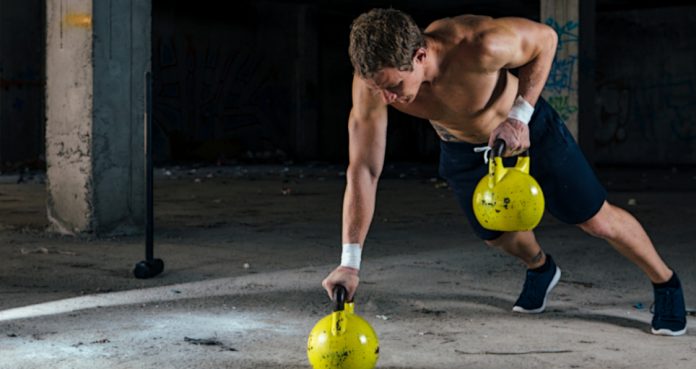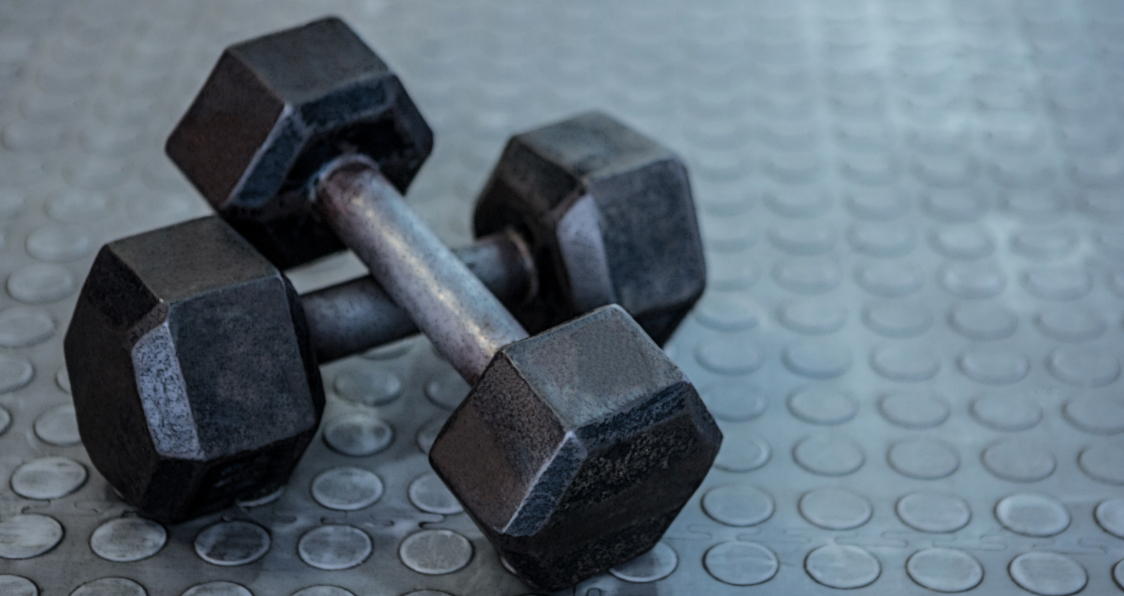
Why You Should Be Using The Renegade Row
Due to its ability to efficiently target multiple muscle groups at one time, the renegade row is one of the greatest dynamic resistance exercises in existence.
The exercise holds much value regardless of whether you are new to strength training or if you have been attending the gym for years.
In addition, there are a number of renegade row variations that can be utilized in order to bring about specific adaptations and advance you towards achieving your health and fitness goals.
As you may be aware, all rowing movements tend to develop the muscles of the upper back and the lats. While the renegade row certainly works these muscles, it requires engagement from many more.
The exercise demands a large degree of stabilization work which comes predominantly from the core. Working the core in this manner will improve midline stability and coordination.
This article will not only detail how exactly to perform the renegade row but will also cover the benefits, common mistakes and variations that are associated with the exercise.
Renegade Row Muscles Worked and Technique
As mentioned, the renegade row requires engagement from a vast array of muscles both to stabilize and drive the movement.
In terms of stabilization, all the muscles which isometrically contract during a plank must do likewise during the renegade row – this includes the glutes, core, and legs (1).
The muscles that are primarily responsible for the rowing movement are the lats, traps, rhomboids, and biceps (2).
Use the following 4 coaching points in order to successfully complete the renegade row and build full-body strength and stability.
1) Set a Solid Base
In preparation for the renegade row, it is imperative that you first set yourself up in a solid and stable position, otherwise, the movement will quickly break down.
Place the dumbbells on the floor so that when you get in the plank position, the shoulders are directly above them weights.
Assume an extended plank position and ensure that the feet are placed anywhere between hip and shoulder-width. The distance you go with is really dependent on what feels best.
If you want to really challenge your stability, go with a narrower stance whereas if you want to increase stability select a slightly wider stance.
If you are new to the renegade row, it is recommended to start with a wider stance initially. As you improve, bring the feet in a fraction to increase the difficulty of the exercise.
2) Engage the Core
Before driving the dumbbells from the floor, engage all the muscles of the core and squeeze the glutes tightly. In addition, drive the heels into the floor as best as possible to keep you grounded.
Bracing the body in this manner will hold you in a straight line as you row and have a positive impact on movement efficiency.
To assist in the bracing process, gradually work your way up the body squeezing the muscles as you go. Set the ankles first, then the knees, hips, core and then finally, the upper body.
3) Nailing the Row
The next step is to powerfully pull one of the dumbbells into the body. It’s really important that the movement is akin to a standard dumbbell row.
Therefore, when pulling the dumbbell, look to keep the shoulder locked down (prevent it from rising upward), tuck the elbow into the side of the body and pull far enough so that elbow moves beyond the level of the back.
A useful tip that may facilitate a great row is to visualize pulling the starter cord of a lawnmower as this is exact movement pattern you want to replicate.
4) Controlling the Eccentric Phase
After completing the concentric part of the exercise (pulling the dumbbell off the floor and into the body), it is imperative that the eccentric (or lowering) phase is well controlled.
While maintaining a full-body brace, gradually lower the dumbbell back down to the floor – this will keep the tension on the muscle for a longer period of time.
Swinging the dumbbell or allowing gravity to take over will not only fail to activate the muscles efficiently but may move you out of a stable position.
If the weight is too heavy, it is likely that this will occur. If this happens to you, consider reducing the overall weight to allow for proper execution of the exercise.
Renegade Row Benefits
Adding the renegade row into your training program can bring about a vast number of benefits. However, there are 3 primary benefits that are associated with this movement.
1) Midline Stability Improvements
Performing a row while in the extended plank position will fire up all core musculature in order to prevent rotation from occurring.
Many joints must be stabilized which therefore requires a powerful isometric contraction from multiple muscle groups to fight the compulsion to rotate the trunk.
Over time, regularly practicing the renegade row will increase core strength and therefore enhance midline stability and total body control.
Improving these aspects can have such a positive impact, not only on athletic performance and injury risk (3) but also more generally in day-to-day life.
2) Building Upper Back and Lat Size
One of the more evident benefits of the renegade rows is the impact that it has on back health. As reflected on earlier, the row is an excellent upper back and lat developer.
Therefore, adding the renegade row into your training program can lead to an increase in both the upper back and lats strength and size.
Adding in extra pulling exercise, such as the renegade row, into your program will increase the number of pulling exercises completed and boost overall training volume.
This is significant as there is a direct relationship between training volume and muscle hypertrophy (4). The greater the volume, the greater the rate of muscle growth.
3) Exercise Adaptability
Finally, this exercise can easily be scaled or adapted to align with your needs and training goals. With the renegade row, it is possible to scale the weight, movement patterns, and implements.
Another great benefit of the renegade row is that it does not require a lot of equipment or extreme weight in order to execute. This makes it an excellent dynamic training tool for practically any workout.
 Renegade Row Common Mistakes
Renegade Row Common Mistakes
There are two very common mistakes to be aware of and avoid when performing the renegade row.
Typically, these errors creep in as a result of one of two things. Either using too much weight or setting up incorrectly prior to starting the exercise.
1) Rotating the Trunk
As discussed, the greatest benefits associated with this exercise will come about through resisting rotation.
Often rotation will occur when too much weight is being used. The body will utilize rotation and move out of the plank position in order to assist the drive of the dumbbell.
Take a moment to remind yourself that both the shoulders and hips should stay neutrally aligned and parallel to the floor throughout the duration of the exercise.
If you find that you are rotating in order to bring the dumbbell up, simply lower the dumbbell weight to allow you to control the movement to a greater degree.
2) Lifting the Feet Off The Floor
One of the most challenging components of the renegade row is keeping the feet grounded while rowing.
Finding a stance that allows you to maintain ground contact throughout is imperative. This may mean experimenting a little with your stance to find what works best for you.
If you find that the feet lift from the floor or move excessively, adjust your stance and consider reducing the weight once again.
Renegade Row Variations
For those who are looking to advance their training or challenge themselves, there are a number of effectual renegade row progressions.
Here are 3 of the best renegade row variations to allow you to further develop full-body strength and stability.
1) Renegade Row with Push-Up
A very simple yet effective variation is to add a push up after completing your rows. To complete one full repetition, row both sides individually and then perform one full push-up.
2) Kettlebell Renegade Row
This variation is for those who are experienced and consider themselves to be at an advanced stage.
Because kettlebells are less stable than dumbbells, this exercise will provide a real challenge in terms of both trunk and shoulder stability.
3) Feet Elevated Renegade Row
Elevating the feet removes 2 points of floor contact which will cause you to feel less stable and increase the difficulty of the exercise.
As a result, the core and hip musculature will be forced to work even harder to hold the body in the correct position.
Final Word
There is no denying that the renegade row is a highly demanding exercise and therefore care must be taken when performing it.
However, when executed correctly, the exercise has the ability to build a strong upper back, lats, and core as well as improving midline stability and movement.
For more news and updates, follow Generation Iron on Facebook, Twitter, and Instagram.
References:
1-Youdas, James W.; Coleman, Kendra C.; Holstad, Erin E.; Long, Stephanie D.; Veldkamp, Nicole L.; Hollman, John H. (2018-3). “Magnitudes of muscle activation of spine stabilizers in healthy adults during prone on elbow planking exercises with and without a fitness ball”. Physiotherapy Theory and Practice. 34 (3): 212–222. doi:10.1080/09593985.2017.1377792. ISSN 1532-5040. PMID 28922049.
2-Lehman, Gregory J; Buchan, Day Deans; Lundy, Angela; Myers, Nicole; Nalborczyk, Andrea (June 30, 2004). “Variations in muscle activation levels during traditional latissimus dorsi weight training exercises: An experimental study”. Dynamic medicine : DM. 3: 4. doi:10.1186/1476-5918-3-4. ISSN 1476-5918. PMID 15228624.
3-Huxel Bliven, Kellie C.; Anderson, Barton E. (2013-11). “Core Stability Training for Injury Prevention”. Sports Health. 5 (6): 514–522. doi:10.1177/1941738113481200. ISSN 1941-7381. PMC 3806175. PMID 24427426.
4-Schoenfeld, Brad J.; Contreras, Bret; Krieger, James; Grgic, Jozo; Delcastillo, Kenneth; Belliard, Ramon; Alto, Andrew (01 2019). “Resistance Training Volume Enhances Muscle Hypertrophy but Not Strength in Trained Men”. Medicine and Science in Sports and Exercise. 51 (1): 94–103. doi:10.1249/MSS.0000000000001764. ISSN 1530-0315. PMC 6303131. PMID 30153194.
